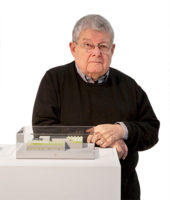Stanley Tigerman, the revered and irreverent unofficial chief of Chicago architects, died yesterday at 88. Stanley (never Stan!) emerged as a fledgling post-modernist with a group of architects dubbed the Chicago Seven in the 1970s, reacting against the pervasive Mies-inspired modernism of their hometown. Though Tigerman earned his B.Arch. and M.Arch. at Yale, he returned to Chicago immediately after getting his final degree. Yet he remained so loyal to his alma mater that, in his later years, when his chronic pulmonary condition prevented him from flying, he would take the train all the way to New Haven to attend final reviews.

His personality was embedded in his architecture—much of it playful and much of it reflecting his deep humanism. He designed an animal rescue center with a facade that included what looked like dog ears, and a house shaped like a hot dog. But he also created the Illinois Holocaust Museum and Education Center in Skokie (2009) and a new facility for the Pacific Garden Mission, a men’s homeless shelter in Chicago (2007)—both of which he described as exemplifying hope. In 1982, joining with his wife and partner, Margaret McCurry, he changed the firm to Tigerman McCurry Architects.
But as much as his architecture, Tigerman will be remembered as a provocateur who gained national stature for his writing, lecturing and participation—with characteristically unbridled remarks—in conferences and debates. In the late 1970s the Chicago Seven (soon to swell to 11 members) enlivened the architectural scene by initiating exhibitions and publications, as well as forums. In addition, Tigerman and crew brought new life to the ailing Chicago Architectural Club, and in 1980 organized the show devoted to reimagining the Chicago Tribune Competition of 1923. By then, there was little dispute that Tigerman had helped loosen Mies’s mantle.
The architect, who titled one of his collections of critical essays, “Schlepping Through Ambivalence,” applied his razor-sharp wit to such designs as a tea and coffee set for Alessi in 1983, currently on display at the Cité de l’architecture et du Patrimoine In Paris. More famous is his collage “Titanic,” which shows Mies’ Crown Hall sinking into Lake Michigan.
In 1993, long before a younger generation of architects turned to working for underserved communities, Tigerman founded Archeworks with Eva Maddox, to engage students in design for the public interest. Before that, he had been director, since 1988, of the School of Architecture at the University of Illinois at Chicago.
And he was always a strong advocate for younger architects, particularly the rising generation of Chicagoans today, including Jeanne Gang and John Ronan.
Here is a tribute to Tigerman from his longtime friend, Robert A.M. Stern:
“Stanley Tigerman was a legendary force – uniquely important for the vitality of Chicago architecture. Time spent with Stanley was time very well spent. He was never bored and never boring. He always thought out of the box and was often a contrarian who held on to his opinions fiercely even when he was demonstrably wrong. Stanley was supremely talented and a risk taker. In addition to his work as an architect, he was a master draftsman, widely admired for his inventive architoons. His drawing of Crown Hall sinking into or rising from Lake Michigan – one was never sure – was the perfect metaphor for the seismic conceptual shift that Stanley did so much to instigate in the 1970s and 1980s.
“Stanley was central to the renewal of Chicago’s status as a center of architectural discourse, something that it had not enjoyed since the era of Sullivan and Wright. To his dying day he saw to it that the debate was an inclusive one – welcoming architects of diverse convictions from both coasts to the numerous symposia and lecture series that he masterminded.
“A talented designer, a superb draftsman, an intellectual and most importantly for me, a friend for almost sixty years. I miss him.”
Peter Eisenman had this to say about Tigerman:
“It is difficult today to imagine a time when Stanley Tigerman, Robert Stern, and myself were together representing the U.S.A. But in fact, this occurred in the first architectural biennale of Venezia in 1976. The exhibition, entitled Europa-America, featured the work of eleven European architects (Rossi, Smithsons, Hollein, etc.) and eleven American architects (among them Bob Venturi and Denise Scott Brown). The theme of the American part was the suburb and featured different views of the suburb as only Stanley, Bob, and I could imagine.
“How powerful was Stanley in Chicago? Its most famous steakhouse, Gene and Georgetti’s, was a hard table to get even in the 1990s. What I did was call ahead for a table and say I was Stanley Tigerman. Upon arrival a quick twenty secured a corner table downstairs. I went so many times that after a while I didn’t even need my alias. When I arrived they would say, 'Good evening, Mr. Tigerman.'”
Read Architectural Record’s 2015 interview with Stanley Tigerman, aka Mr. Chicago.









Post a comment to this article
Report Abusive Comment